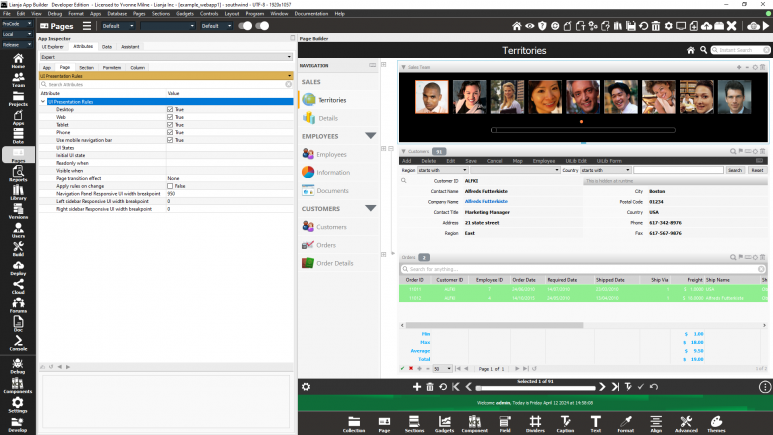UI Presentation Rules
A Lianja App can have multiple UI personalities and different functionality depending on the "roles" that you grant to a user and also the device on which the App is being run e.g. Desktop, Web or Mobile.
The Lianja App Builder provides the ability for you to build one App that will run on Desktop, Web and Mobile devices from a single codebase.
Certain UI Elements may only be relevant to a Desktop user, others to a Web user and some only to a Mobile user. Additionally some UI elements may only be visible when running on a Mobile device if the device is in "landscape mode". You can adjust the behavior of an App using UI Personalities.
These are specified in the attributes for a UI Element in the attributes Tab of the App Inspector.
Contents
Desktop
The Desktop attribute determines whether this element should be included in a Desktop client or not.
Web
The Web attribute determines whether this element should be included in a Web client or not.
- Note that if the App's Web attribute is unchecked (False), Web App View is disabled.
Tablet
The Tablet attribute determines whether this element should be included in a Tablet client or not.
- Note that if the App's Tablet attribute is unchecked (False), Tablet App View is disabled.
Phone
The Phone attribute determines whether this element should be included in a Phone client or not.
- Note that if the App's Phone attribute is unchecked (False), Phone App View is disabled.
The Use mobile navigation bar attribute specifies whether a mobile styled navigation bar (material UI style) should be used. From v4.1.
UI States
The UI States attribute specifies the UI states that affect this element.
- Multiple states should be specified as a comma separated list.
- See UI States.
Initial UI state
The Initial UI state attribute specifies the starting UI state for this element.
- See UI States.
Readonly when
The Readonly when attribute specifies an expression to be evaluated. If the expression evaluates to True, the element is readonly (not editable).
- The Readonly when attribute expression is evaluated at runtime only.
Visible when
The Visible when attribute specifies an expression to be evaluated. If the expression evaluates to True, the element is visible.
- The Visible when attribute expression is evaluated at runtime only.
Page transition effect
The Page transition effect attribute specifies the page transition effect to use when navigating to this page on the Web/Mobile client. (None | Fade | Pop | Flip | Turn | Flow | SlideFade | Slide | SlideUp | SlideDown).
- Applies to Pages only.
Display orientation
The Display orientation attribute determines whether this element is always displayed, only when the orientation is portrait or only when the orientation is landscape. (Always | Portrait | Landscape).
- Applies to mobile devices only.
Hidden at runtime
The Hidden at runtime attribute determines whether this formitem or grid column is hidden at runtime(True | False). Default is False.
- Applies to Form Section Fields, Advanced Canvas Controls and Grid Columns.
- This can be used to hide certain fields in a form or grid that you may need but do not want the users to see e.g. a primary key field which needs to be defined for Virtual Tables so that Update and Delete operations can be performed.
Apply rules on change
The Apply rules on change attribute determines whether the UI presentation rules of the page and its elements should be applied when data is changed interactively and when navigating records (True | False).
- If checked (True), when data changes in this page, section, gadget or formitem (Form Section field or Canvas Advanced Control), the page and its elements' Visible when and Readonly when expressions will be re-evaluated.
Apply rules on parent change
The Apply rules on parent change attribute determines whether the UI presentation rules of this section and its elements should be applied when parent data is changed by navigating records (True | False).
- If checked (True), when data changes in its related parent section, the section and its elements' Visible when and Readonly when expressions will be re-evaluated .
- Applies to Sections.
Notes on Client Support
| Attribute | Notes |
|---|---|
| Desktop | - |
| Web | - |
| Tablet | - |
| Phone | - |
| UI States | UI States are supported on the Desktop client only. |
| Initial UI state | The Initial UI State is supported on the Desktop client only. |
| Readonly when | Readonly when is supported on the Desktop client only. |
| Visible when | Visible when is supported on the Desktop client only. |
| Page transition effect | The Page transition effect is ignored on the Desktop client. |
| Display orientation | The Display orientation is ignored on the Desktop client and fixed orientation devices. |
| Hidden at runtime | - |
| Apply rules on change | Apply rules on change is supported on the Desktop client only. |
| Apply rules on parent change | Apply rules on parent change is supported on the Desktop client only. |
